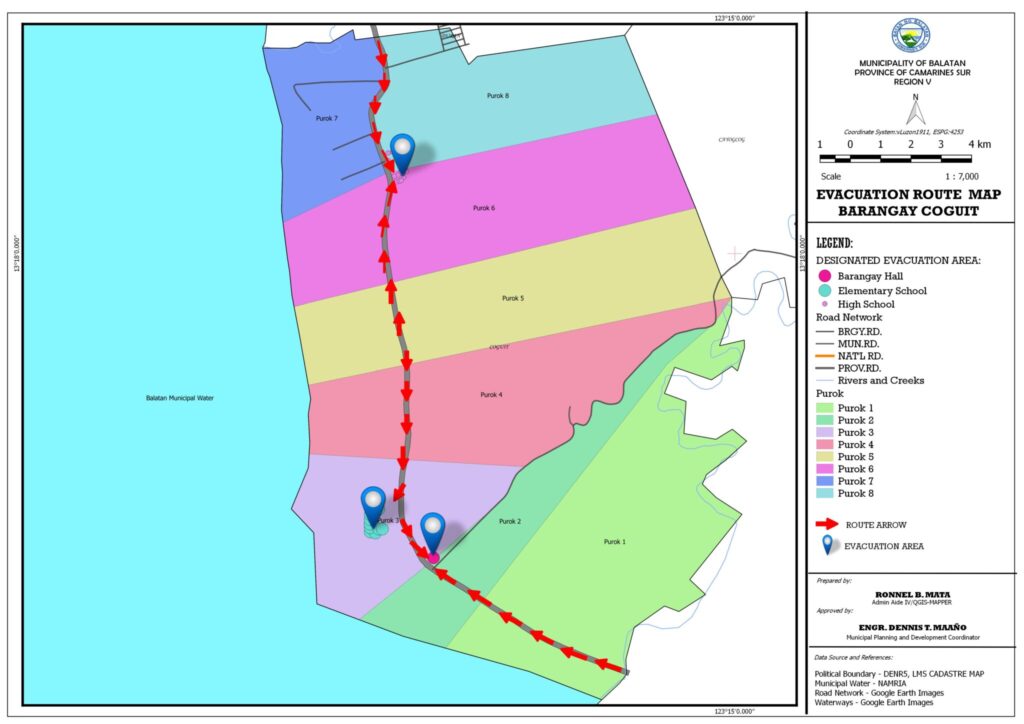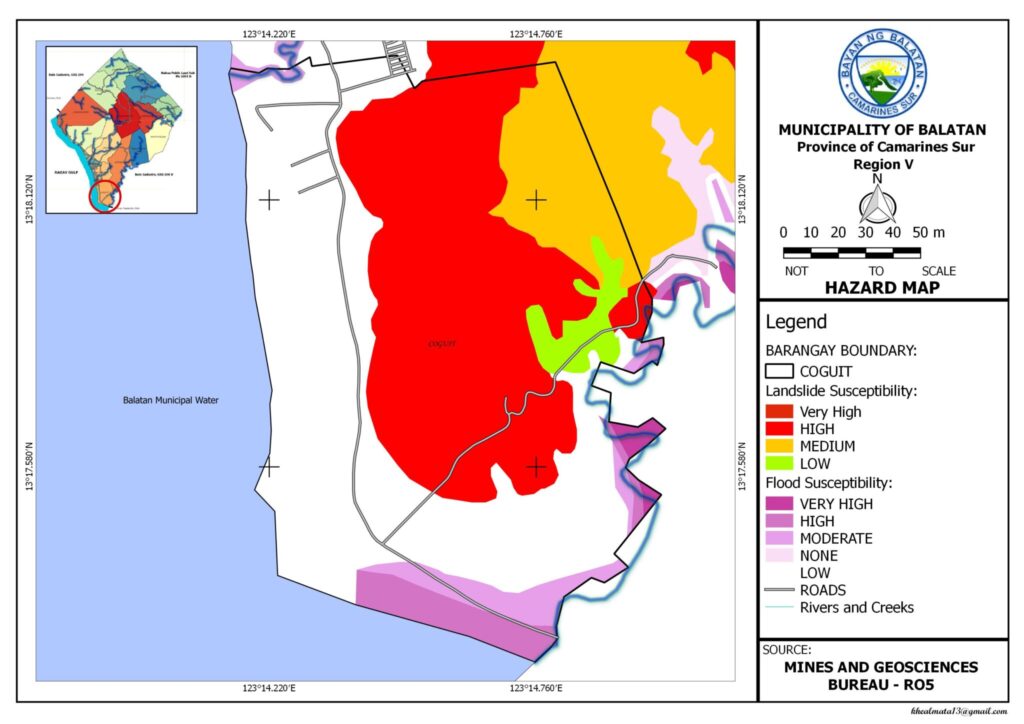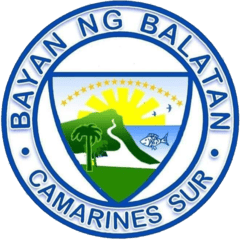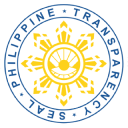COGUIT HANDA!
COGUIT HOTLINE: 0919911-011 | BALATAN HOTLINE: 0915-777-1234 | 0989-111-1234 | 054-8113434 | FB: Balatan Rescue

COGUIT EVACUATION ROUTE

COGUIT HAZARD MAP
Mga pangunahing hazards na nakakaapekto sa Barangay Coguit
| HAZARDS | PROBABILIDAD | EPEKTO | RANK |
|---|---|---|---|
| Tropical cyclone | Madalas dumaan ang bagyo at iba pang sama ng panahon sa lugar. | 60% ng mga bahay ay gawa sa magagaan na materyales. | 1 |
| Flash flood | Madalas dumaan ang bagyo at iba pang sama ng panahon sa lugar. | Ang kabahayan at pasilidad ng pamahalaan ay matatapatan sa mga lugar na panganib. | 4 |
| Fire | Mataas ang populasyon sa baybayin. | Ang mga bahay ay gawa sa magagaan na materyales at may presensya ng mga depot. | 5 |
| Storm surge | May 6 na barangay na nakalatag sa tabing-dagat. | Mataas ang populasyon sa mga baybaying. | 2 |
| Drought | May mga lugar na walang kabuhayan. | Ang pinagkukunan ng pagkain, tubig, sariwang hangin, at likas na kapaligiran ay pangungahing nakadepende sa balanseng suplay ng sikat ng araw at tubig. | 3 |
| Landslide | Ang lokasyon pangkalahatan ay bulubundukin at binubuo ng limestone. | Ang mga kabahayan ay matatapuan sa paanan ng mga lugar na mataas ang panganib. | 6 |
Populasyon na nasa panganib sa scenario ng isang Super Typhoon sa Coguit
| Zone | Population | Summary of individuals projected to be affected by a Super Typhoon (scenario) | Reason for displacement | |||||||||
| HH | Families | Indivual | Individual | Infant | Children | Adult | Elderly | PWD | Sick | Pregnant | ||
| 1 | 275 | 0 | 103 | 152 | 20 | 4 | 12 | 0 | Risk of storm surge/ light housing materials | |||
| 2 | 329 | 1 | 113 | 195 | 20 | 3 | 18 | 0 | ||||
| 3 | 341 | 2 | 121 | 186 | 32 | 6 | 31 | 2 | ||||
| 4 | 407 | 2 | 131 | 243 | 31 | 7 | 36 | 4 | ||||
| 5 | 156 | 1 | 48 | 96 | 11 | 3 | 10 | 1 | ||||
| 6 | 268 | 2 | 99 | 150 | 17 | 3 | 22 | 0 | ||||
| 7 | 280 | 2 | 96 | 163 | 19 | 5 | 15 | 1 | ||||
| 8 | 995 | 9 | 374 | 542 | 70 | 12 | 58 | 2 | ||||
| Total | 550 | 613 | 2,532 | 3,051 | 19 | 1,085 | 1,727 | 220 | 43 | 202 | 10 | |
Early Warning System
| Level ng Alerto | Sitwasyon | Pag-monitor sa tamang detalye tungkol sa darating na sakuna | Mga paghahanda at dapat gawin ng pamilya | Mga paghahanda ng BDRRMC | Responsible agencies/person |
|---|---|---|---|---|---|
| Alert 0 | Maghintay ng update sa PAGASA. Paghahanda ang paparating na masamang panahon | Magbandilyo, Magbantay ng tubo, Mag house-to-house | E-balde, Go bag, Mag importanteng dokumento, Cash, flashlight, cell phone | Magpulong ang mga brgy. council, Mag-monitor/evacuate, Ihanda na sasakyan ng mga barangay officials | BDRRMC / BLGU / Volunteers |
| Alert 1 | I-anunsyo/pamalita sa komunidad | Magbandilyo, Mag house-to-house | Bawal na pumalaot! Ilikas na rin ang mga st. citizen, bata, PWD at mga buntis | Magbigay na rin ng relief goods, I-monitor ang mga evacuees sa evacuation center | BDRRMC / BLGU / Volunteers |
| Alert 2 | Isang araw bago dumating ang sakuna, ipagbigay alam na sa buong komunidad para sila’y makapaghanda | Magbandilyo, Kalembang ng sampung beses sa isang araw | Maghanda at sabihin ang pamilya na pumunta na sa Evac Center, Maki-ugnay sa TV o radyo | Force evacuation | BDRRMC / BDRRMO / BLGU |
| Alert 3 | Magbanta sa balita galing sa PAGASA at tumutok | Magbandilyo, Megaphone, Gumamit ng red flag senyales sa mga tabing kalsada, TV/radyo | Siguraduhing makapunta sa Evacuation Center ang buong pamilya | Bibigyan ng ayuda / relief ang mga nasa Evacuation Center | BDRRMC / BDRRMO / BLGU / Volunteers |
| Safe / Ligtas | Base sa ulat ng PAGASA ay nakaalis na ng PAR ang bagyo | Magbandilyo sa mga evacuees na makakauwi na sa kanilang bahay, Magbandilyo sa buong brgy. na ligtas na sabihing ay safe ang community | Makipag-ugnayan sa BDRRMC at BLGU, Bago umalis ay linisan at ibalik ang gamit sa Evacuation Center | Magdeklarang pwede na umuwi sa mga kanya-kanyang bahay ang mga evacuees, Clearing operation | BDRRMC / BDRRMO / BLGU / Volunteers |
Barangay Coguit History
The name “Coguit” has several stories that have been orally handed down by the early settlers of the area. According to former Barangay Captain Ernesto B. Bongalon, during the Spanish era, the Spaniards arrived by water transportation at low tide, and the locals went out to meet them. While pointing to an octopus, referred to in Bicol as “Coguita,” a Spanish stranger asked for the name of the place. The unsuspecting inhabitant replied “Coguita,” unaware that the Spaniards had misunderstood, thinking it was the name of the location. This term has since been used for many years.
Another account, shared by former Barangay Captain Gemeniano Belbis, suggests that the name Coguit is derived from “Coguitahan,” meaning a place famous for octopus. During low tide, people from neighboring areas would visit to gather octopus for their meals.
In 1934, after the Philippines gained independence from American rule, the area became home to several families, including Leon Santos, Ricardo Romano Sr., Roman Cana, Pedro Belbis, and Meliton Barrameda. Between 1931 and 1950, Barangay Coguit was still considered a sitio and part of the Municipality of Bato. However, on December 31, 1951, Executive Order No. 485, issued by the late President Elpidio Quirino, proclaimed Balatan as a separate town. During this time, Mayor Gregorio Balatan, the first mayor of the new town, began to delineate the municipal boundary. Ultimately, Mayor Pio Mota of Bato and Mayor Balatan agreed that the river would serve as the boundary between the municipalities of Balatan and Bato, leading to Barangay Coguit officially becoming part of the Municipality of Balatan.
The Patron Saint of Barangay Coguit is Saint Raphael, the Archangel, and its feast day is celebrated on October 25th. The first school in Coguit was established in 1952 under the supervision of the then Ministry of Education, Culture, and Sports.
Coguit Barangay Profile




